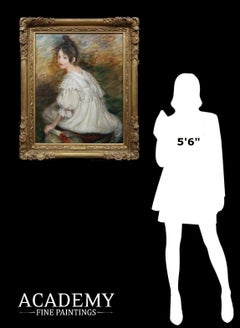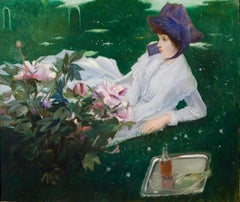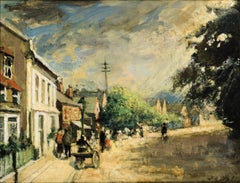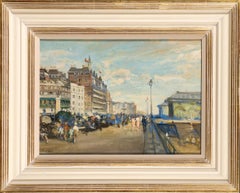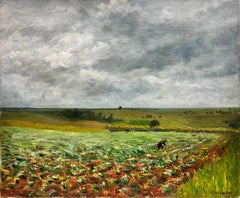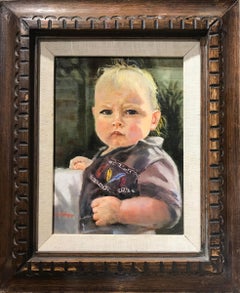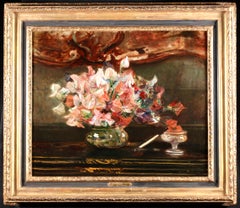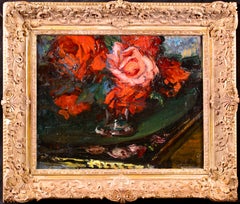Jacques Emile Blanche Paintings
French
Born into a wealthy French family of eminent psychiatrists, Jacques-Émile Blanche grew up surrounded by literary and artistic influences. His father was an important collector of Impressionist paintings and was friends with (and often physician to) many of the great art world figures of 19th century Paris.
Although he received some formal training from Henri Gervex (1852-1929), Jacques-Émile Blanche undoubtedly learned most from his early mentor Edouard Manet and his friends James Whistler, John Singer Sargeant, Giovanni Boldini, and James Tissot. During his long and successful career Blanche painted many street scenes of late Victorian London but became most famous as a portrait painter. Like his father, Blanche was a popular and gregarious character, and a close friend of just about every important figure in Belle Epoque Paris. He painted famous portraits of Marcel Proust, Virginia Woolf, Aubrey Beardsley, James Joyce, Colette, Edgar Degas, Claude Debussy, Henry James, Auguste Rodin, Thomas Hardy, John Singer Sargent, Walter Sickert, Vaslav Nijinsky, Tamara Karsavina, Jean Cocteau, Ida Rubinstein, Stéphane Mallarmé, Igor Stravinsky, Paul Valéry, Aldous Huxley, and D.H. Lawrence in addition to Royalty and just about every prominent society beauty of the Belle Epoque.
Between 1881 and his death in 1945 Jacques-Émile Blanche exhibited in Paris at the Salon des Artistes, the Société Nationale des Beaux-Arts (of which he was founder member), and the Exposition Universelle of 1900, in London at the Royal Academy and the New English Arts Club, and at the Venice Biennale where he was awarded a gold medal. He also became a renowned master to numerous students during his time at the Académie Vitti, one of the first schools to accept female students, and subsequently at the Académie de La Palette. In the 1930 he was made a Commander of the Légion d’Honneur and five years later was elected to the Académie des Beaux-Arts, the most distinguished position any French artist could be offered by the state.
Today, works by Blanche can be found in the collections of the Musée d'Orsay in Paris, the National Gallery and National Portrait Gallery in London, the Art Institute of Chicago, Oxford University’s Ashmolean Museum, Harvard University Art Museums, the Hermitage Museum in St. Petersburg, the New York Metropolitan Museum of Art, and Tate Britain in London among many others.to
3
1
1
1
3
Overall Width
to
Overall Height
to
2
4
1
1
2
1
1
3
3
4
2
1
1
1
1
1
1
6
6
2
2
1
6
783
708
700
694
6
5
1
Artist: Jacques Emile Blanche
Jeune Fille en Blanc - 19th Century French Impressionist Oil Painting Portrait
By Jacques Emile Blanche
Located in Gerrards Cross, GB
‘Jeune Fille en Blanc’ by Jacques-Émile Blanche (1861-1942).
The painting – which depicts one of the artist’s favourite models Wanda Zielinska – is signed and dated 1896. It is lis...
Category
Late 19th Century Impressionist Jacques Emile Blanche Paintings
Materials
Oil
Floral Bouquet - French circa 1900 Impressionist art oil painting of flowers
By Jacques Emile Blanche
Located in Hagley, England
This superb Edwardian floral oil painting is by noted French Impressionist artist Jacques-Emile Blanche. From 1884 Blanche spent a lot of time in England and regularly exhibited at the Royal Academy...
Category
Early 1900s Impressionist Jacques Emile Blanche Paintings
Materials
Oil
Sunflower Floral Arrangement - French 1930's Art Deco flower oil painting
By Jacques Emile Blanche
Located in Hagley, England
This vibrant French Art Deco floral oil painting is by noted French artist Jacques Emile Blanche. Painted circa 1930, the palette is of wonderful tones of yellow and orange with spla...
Category
1930s Art Deco Jacques Emile Blanche Paintings
Materials
Oil
Henriette Chabot with Peonies
By Jacques Emile Blanche
Located in Mc Lean, VA
This painting was owned by Comte Robert de Montesquiou (1855–1921), Paris
Literature:
Jane Roberts, Jacques-Émile Blanche (2012), pg. 47 (color illus.), p. 191.
Included as no. R...
Category
Early 20th Century Post-Impressionist Jacques Emile Blanche Paintings
Materials
Canvas, Oil
Rue de village en Angleterre
By Jacques Emile Blanche
Located in Barbizon, FR
Provenance:
-Collection Anna de Noailles , then her descendants
-Collection Lesieutre, Sotheby's sale in June 2017, lot n°159
-Online Catalogue Raisoné reference n°RM694
A pupil of G...
Category
19th Century Barbizon School Jacques Emile Blanche Paintings
Materials
Oil, Wood Panel
King's Road, Brighton
By Jacques Emile Blanche
Located in Belgravia, London, London
Oil on canvas
Canvas size: 13 x 18.25 inches
Framed size: 19.5 x 24.5 inches
Signed lower left
Category
20th Century Jacques Emile Blanche Paintings
Materials
Canvas, Oil
Related Items
Mid Century French Post Impressionist Oil on Canvas Man Working in Fields
By Josine Vignon
Located in Cirencester, Gloucestershire
Working in the Fields
by Josine Vignon (French 1922-2022)
signed and stamped verso
oil painting on canvas, unframed
canvas: 21 x 26 inches
very good condition
provenance: from the a...
Category
Mid-20th Century Post-Impressionist Jacques Emile Blanche Paintings
Materials
Canvas, Oil
$1,314 Sale Price
20% Off
H 21 in W 26 in D 1 in
Take Me Home, 12x8" oil, framed
By Lu Haskew
Located in Loveland, CO
"Take me Home" by Lu Haskew
Oil 19x16" framed, 12x8" image size
Signed lower left
A young child very apparently ready to go home from their intense yet cute look. The child is weari...
Category
Early 2000s American Impressionist Jacques Emile Blanche Paintings
Materials
Canvas, Oil
Landscape with castle oil on canvas painting
By Rafael Griera Calderón
Located in Sitges, Barcelona
Frame size 78x87 cm.
Rafael Griera Calderón was born incidentally in Las Palmas de Gran Canaria in 1934. After residing in Olot from 1942 to 19...
Category
1990s Post-Impressionist Jacques Emile Blanche Paintings
Materials
Oil, Canvas
$658 Sale Price
44% Off
H 18.12 in W 21.66 in
Vintage Irises and Daisies Still Life
Located in Soquel, CA
Wonderful 1970s still life of Japanese irises and marguerite daisies by Winona Cappell (American, 20th century). Signed lower right corner. Unframed. Image size: 24"H x 18"W.
Cappel...
Category
1970s American Impressionist Jacques Emile Blanche Paintings
Materials
Canvas, Oil
$476 Sale Price
20% Off
H 24 in W 18 in D 1 in
Flowers in terracotta pot - Still life Oil on canvas
Located in Geneva, CH
Unsigned
Work on canvas
Gilded wooden frame
70,5 x 48 x 4,5 cm
Category
Mid-20th Century Art Deco Jacques Emile Blanche Paintings
Materials
Oil
$408 Sale Price
49% Off
H 24.02 in W 14.97 in D 0.79 in
Mid Century Pink & White Roses in Crystal Vase Still-Life
By Helen Enoch Gleiforst
Located in Soquel, CA
Delicate mid century still-life of white and pink roses in crystal vase with a soft, lime green background by listed California artist Helen Mae Enoch Gleiforst (American, 1903-1997)...
Category
1950s American Impressionist Jacques Emile Blanche Paintings
Materials
Canvas, Oil
$1,950
H 24 in W 20 in D 1 in
20th French Post Impressionist Oil Busy Summer Beach Scene Many Figures & Color
By Josine Vignon
Located in Cirencester, Gloucestershire
Sur la Plage
by Josine Vignon (French 1922-2022)
signed lower right
oil painting on canvas, unframed
canvas: 20 x 25.5 inches
Colors: Yellow gold and warm colors, red, blue and ora...
Category
Mid-20th Century Post-Impressionist Jacques Emile Blanche Paintings
Materials
Canvas, Oil
Josine Vignon20th French Post Impressionist Oil Busy Summer Beach Scene Many Figures & Color, 1960's
$2,639 Sale Price
20% Off
H 20 in W 25.5 in D 1 in
Vertical Floral Still Life
By Doreen Gadsby
Located in Soquel, CA
Highly impasto still life of brightly colored flowers in a vase by Doreen Gadsby (Australian, b. 1926). Signed "Gadsby" in lower right corner. Presented in a green wood frame. Image size: 44.25"H x 22.13"W
Doreen Gadsby (Australian, b. 1928) was born to a farming family in Lismore, Australia, and later studied at East Sydney Technical College (now the National Art School) in Darlinghurst during World War II. As a young mother of four, she joined the same art club as Lloyd Rees and a 17-year-old Brett Whiteley...
Category
1980s Impressionist Jacques Emile Blanche Paintings
Materials
Canvas, Oil
Yellow Flowers
Located in Zofingen, AG
In crafting this piece, I drew upon the vibrant energy of nature, channeling the raw emotions and the essence of impressionism and expressionism. Utilizing acrylics and oils, I creat...
Category
2010s Impressionist Jacques Emile Blanche Paintings
Materials
Oil, Acrylic
Mid Century Portrait of the Artist
Located in Soquel, CA
Mid-century self-portrait by California artist Myrtle Cureton (American, 1909-2000). Signed "Myrtle Cureton" lower left. Artist's Santa Cruz Art League ...
Category
1950s American Impressionist Jacques Emile Blanche Paintings
Materials
Masonite, Oil
$1,080 Sale Price
20% Off
H 17.75 in W 14.25 in D 0.25 in
"Parisian Street", Cityscape Oil on Canvas by Robert Farrington
Located in Pasadena, CA
This Robert Farrington's painting serves as a visual gateway to a distinct period in post-war France, composed with a deep respect for the elements interwoven into the collective memory of Paris. His work adeptly engages with the archetypal settings and concepts that convey the quintessence of this beloved and frequently visited capital.
As the viewer gazes upon this artwork, they are instantly immersed in the ambiance of a food trade street, and especially the familiar historic brasserie “Au Pied de Cochon” - the sole establishment in the painting that still exists nowadays - and its surroundings at the heart of the bustling Halles district. At "6 Rue Coquillère", the act of opening the doors, each adorned with handles that resemble pig's trotters, transports one through a temporal gateway into the quintessential French world of "la cochonnaille"... The renowned "Pied de Cochon" restaurant made its debut in 1947. In its early days, it became the preferred gathering place for the "Forts des Halles" – the diligent laborers who tirelessly transported goods through the pavilions of the old Halles de Paris. From these dedicated workers to the luminaries of the time, this establishment emerged as a symbol of Parisian life. Farrington reconstructs a scene around this restaurant, nourished by her own Parisian experience when he was a young American living in France. An iconic Brigitte Bardot poster...
Category
Late 20th Century Post-Impressionist Jacques Emile Blanche Paintings
Materials
Canvas, Oil
$1,200
H 38 in W 38 in D 1.25 in
ORIGINAL 1860 Famous American Artist Henry Peters Gray (1819-1877) oil on canvas
By Henry Peters Gray
Located in Palm Coast, FL
Up for sale is an amazing original antique oil painting on canvas by Famous American Artist Henry Peters Gray (1819-1877), depicting a portrait of a W.P. Wright Esq.
Some of his paintings are exhibited in the Metropolitan Museum of Art, in New York.
The painting has a commemorative inscription on the verso: "For W.P. Wright Esq. Portrait from Henry Peter Gray. Painted at Pittsfield MA August 1860.
Please read some interesting information about this Artist from Wikipedia.
Henry Peters Gray was born in New York City he was a pupil of Daniel Huntington...
Category
1860s Impressionist Jacques Emile Blanche Paintings
Materials
Oil
$3,350 Sale Price
50% Off
H 35 in W 30 in D 2 in
Previously Available Items
Bouquet - Post Impressionist Still Life Oil Painting by Jacques-Emile Blanche
By Jacques Emile Blanche
Located in Marlow, Buckinghamshire
Signed post impressionist still life oil on canvas circa 1895 by French painter Jacques-Emile Blanche. The work depicts a ceramic vase filled with white and pink sweet pea flowers...
Category
Late 19th Century Post-Impressionist Jacques Emile Blanche Paintings
Materials
Canvas, Oil
Les Roses de L'Etang - Post Impressionist Oil, Flowers by Jacques-Emile Blanche
By Jacques Emile Blanche
Located in Marlow, Buckinghamshire
Signed post impressionist still life oil on canvas by French painter Jacques-Emile Blanchard. The work depicts a glass vase filled with red roses placed on a table in an interior. A wonderfully brushed piece by this sought after artist.
Signature:
Signed lower right
Dimensions:
Framed: 19"x22"
Unframed: 13"x16"
Provenance:
The collection of Andre Maurois (1885-1967)
This work is included in the catalogue raisonne of the painter prepared by Jane Roberts under reference RM 839
Blanche received training from Gervex and Fernand Humbert. His grandfather was Émile Antoine Blanche, the psychiatrist who treated the poet Gérard de Nerval on several occasions. He was awarded a gold medal at the Exposition Universelle in Paris in 1900, and was a Commander of the Légion d'Honneur. He was well known in French and British artistic circles, and married the daughter of John Lemoine, the leader of the Diary of the Proceedings ( Journal des Débats), and author of the Life of Brummel. He exhibited his works in London and Paris.
Blanche had a wide circle of acquaintances, and the list of portraits which he executed is indicative of the diversity of those who used to meet at his home: Henri Bergson; Stéphane Mallarmé; Henry Bernstein (1902); André Gide (1912); Anna de Noailles (1912); Jean Cocteau (1912); Igor Stravinsky (1915); Francis Jammes (1917); Paul Claudel (1919); Jean Giraudoux; Paul Valéry; Marcel Proust; Max Jacob (1921); Maeterlinck (1931); Debussy; Antoine Bourdelle; George Moore; André Maurois; François Mauriac; Maréchal Foch and the Princess de Broglie.
He also wrote novels, which were more or less autobiographical, and essays, such as From David to Degas; Dates; From Gauguin to the Negro Review; Journals of an Artist ( De David à Degas; Dates; De Gauguin à la Revue nègre; Cahiers d'un artiste) in six volumes, and Manet. During meetings at his studio, he used to collect any snippets that would flesh out the essays he wrote, which alternated between being sharp and emotive. He gave them in series to the magazine Comoedia, under the title of Studio Talk. It was said that he aroused tremendous debate, notably with André Lhote, a painter younger than himself, who also doubled as a critic. The latter initially attempted to define the main characteristics of the art of the 'rebellious and charming Jacques Émile Blanche,' but subsequently treated him less generously, referring to a painter 'attached to the notion of 'high-and-mighty' genre painting.' He added that this sort of painting was marvellously illustrated by Manet.
The quality of his flat surfaces, the precious greys and silvery light effects cause Jacques Émile Blanche to be compared more with Manet, whom he admired, than with the Impressionists, with whom he was compared in terms of his early works. Nevertheless, his outdoor backgrounds with traces of sometimes vivid colours have something in common with them.
In the aftermath of World War I, he spent a long time on an enormous composition entitled Tribute to those who Died in the War. It was executed in a style which was totally different to his work as a whole. He offered this work to the church in Offranville near Dieppe. He also donated around 100 of his works to the Musée des Beaux-Arts in Rouen.
He regularly exhibited in Paris, at the Salon of the Société Nationale des Beaux-Arts (also known as the Salon de Mars) from the time it was founded in 1890. At the time of the initial exhibitions held by the Société Nationale des Beaux-Arts, he rapidly gained fame by exhibiting such portraits as Paul Adam and Charles Cottet. He sometimes grouped together several members of the same family in one painting: The Painter Thaulow and His Family in 1895, The Vielé-Griffin Family, and numerous refined portraits of key figures in France and England.
Apart from this Salon, for which he was one of the first driving forces and founder members, he was later to put in a great deal of effort on the occasion of the Salon des Tuileries between 1933 and 1939, even though he was by then in his seventies and already famous.
He exhibited genre scenes, scenes of fashionable places - like Brighton or Dieppe - and racecourse scenes at the Salon des Tuileries in 1933. These included Family of Pedlars in London; Portrait of the Female Novelist Sylvia Thompson; Racecourses in Ireland; Arrival of the Herring in Dieppe; White Masts; Brighton; in 1934: Portrait of James Joyce; Grand National Steeplechase; Spring Races in England (sketch); Dieppe Beach; Outer Harbour of Dieppe in Autumn; in 1935: Rugby; Walter Richard Sickert; Dieppe; Tea Party at the Madeleine; in 1939: Love Thy Neighbour. Many exhibitions have been dedicated to him since his death, including one at the Musée des Beaux-Arts in Rouen in 1997, and one at the Galerie Philippe Heim in Paris in 1999.
Museum and Gallery Holdings:
Brussels: Portrait of the French Painter Charles Cottet
Dieppe: Sleeping Child; Fish Week
Dijon: General Mangin; The Sailing Ship
London (Tate Collection): Francis Poictevin (1887, oil on canvas, portrait); Charles Conder (1904, oil on canvas, portrait); Ludgate Circus: Entrance to the City (November, Midday) (c. 1910, oil/panel); August Morning, Dieppe Beach (c. 1934, oil on canvas); other paintings
Lyons: Portrait of Debussy
Mulhouse: Begonias
Paris (Louvre): The Painter Thaulow and his Family (1895)
Paris (MAM): The Pink Room; The Port at Le Havre; Flowers in a Vase; Still-life; Portrait of the Artist's Mother (June 1895); Portrait of Igor Stravinsky
Paris (Mus. Carnavalet): Portrait of Jean Cocteau...
Category
1930s Post-Impressionist Jacques Emile Blanche Paintings
Materials
Canvas, Oil
La Salle a Manger a Offranville - 20th Century Oil by Jacques Emile Blanche
By Jacques Emile Blanche
Located in Marlow, Buckinghamshire
A lovely oil on board by French Impressionist painter Jacques Emile Blanche showing an interior view of a dining room with painted red chairs, a birdcage to the right, a lantern hanging from the mantel piece and china cups and saucers on top of it. The piece was painted in the dining room of the artist's home in Offranville where he lived for 60 years. Signed lower left. Framed dimensions are 19 inches high by 15 inches wide.
Blanche received training from Gervex and Fernand Humbert. His grandfather was Émile Antoine Blanche, the psychiatrist who treated the poet Gérard de Nerval on several occasions. He was awarded a gold medal at the Exposition Universelle in Paris in 1900, and was a Commander of the Légion d'Honneur. He was well known in French and British artistic circles, and married the daughter of John Lemoine, the leader of the Diary of the Proceedings ( Journal des Débats), and author of the Life of Brummel. He exhibited his works in London and Paris.
Blanche had a wide circle of acquaintances, and the list of portraits which he executed is indicative of the diversity of those who used to meet at his home: Henri Bergson; Stéphane Mallarmé; Henry Bernstein (1902); André Gide (1912); Anna de Noailles (1912); Jean Cocteau (1912); Igor Stravinsky (1915); Francis Jammes (1917); Paul Claudel (1919); Jean Giraudoux; Paul Valéry; Marcel Proust; Max Jacob (1921); Maeterlinck (1931); Debussy; Antoine Bourdelle; George Moore; André Maurois; François Mauriac; Maréchal Foch and the Princess de Broglie.
He also wrote novels, which were more or less autobiographical, and essays, such as From David to Degas; Dates; From Gauguin to the Negro Review; Journals of an Artist ( De David à Degas; Dates; De Gauguin à la Revue nègre; Cahiers d'un artiste) in six volumes, and Manet. During meetings at his studio, he used to collect any snippets that would flesh out the essays he wrote, which alternated between being sharp and emotive. He gave them in series to the magazine Comoedia, under the title of Studio Talk. It was said that he aroused tremendous debate, notably with André Lhote, a painter younger than himself, who also doubled as a critic. The latter initially attempted to define the main characteristics of the art of the 'rebellious and charming Jacques Émile Blanche,' but subsequently treated him less generously, referring to a painter 'attached to the notion of 'high-and-mighty' genre painting.' He added that this sort of painting was marvellously illustrated by Manet.
The quality of his flat surfaces, the precious greys and silvery light effects cause Jacques Émile Blanche to be compared more with Manet, whom he admired, than with the Impressionists, with whom he was compared in terms of his early works. Nevertheless, his outdoor backgrounds with traces of sometimes vivid colours have something in common with them.
In the aftermath of World War I, he spent a long time on an enormous composition entitled Tribute to those who Died in the War. It was executed in a style which was totally different to his work as a whole. He offered this work to the church in Offranville near Dieppe. He also donated around 100 of his works to the Musée des Beaux-Arts in Rouen.
He regularly exhibited in Paris, at the Salon of the Société Nationale des Beaux-Arts (also known as the Salon de Mars) from the time it was founded in 1890. At the time of the initial exhibitions held by the Société Nationale des Beaux-Arts, he rapidly gained fame by exhibiting such portraits as Paul Adam and Charles Cottet. He sometimes grouped together several members of the same family in one painting: The Painter Thaulow and His Family in 1895, The Vielé-Griffin Family, and numerous refined portraits of key figures in France and England.
Apart from this Salon, for which he was one of the first driving forces and founder members, he was later to put in a great deal of effort on the occasion of the Salon des Tuileries between 1933 and 1939, even though he was by then in his seventies and already famous.
He exhibited genre scenes, scenes of fashionable places - like Brighton or Dieppe - and racecourse scenes at the Salon des Tuileries in 1933. These included Family of Pedlars in London; Portrait of the Female Novelist Sylvia Thompson; Racecourses in Ireland; Arrival of the Herring in Dieppe; White Masts; Brighton; in 1934: Portrait of James Joyce; Grand National Steeplechase; Spring Races in England (sketch); Dieppe Beach; Outer Harbour of Dieppe in Autumn; in 1935: Rugby; Walter Richard Sickert; Dieppe; Tea Party at the Madeleine; in 1939: Love Thy Neighbour. Many exhibitions have been dedicated to him since his death, including one at the Musée des Beaux-Arts in Rouen in 1997, and one at the Galerie Philippe Heim in Paris in 1999.
Museum and Gallery Holdings:
Brussels: Portrait of the French Painter Charles Cottet
Dieppe: Sleeping Child; Fish Week
Dijon: General Mangin; The Sailing Ship
London (Tate Collection): Francis Poictevin (1887, oil on canvas, portrait); Charles Conder (1904, oil on canvas, portrait); Ludgate Circus: Entrance to the City (November, Midday) (c. 1910, oil/panel); August Morning, Dieppe Beach (c. 1934, oil on canvas); other paintings
Lyons: Portrait of Debussy
Mulhouse: Begonias
Paris (Louvre): The Painter Thaulow and his Family (1895)
Paris (MAM): The Pink Room; The Port at Le Havre; Flowers in a Vase; Still-life; Portrait of the Artist's Mother (June 1895); Portrait of Igor Stravinsky
Paris (Mus. Carnavalet): Portrait of Jean Cocteau...
Category
Early 20th Century Impressionist Jacques Emile Blanche Paintings
Materials
Oil, Board
Flowers - 19th Century Oil, Still Life Vase Red Flowers by Jacques-Emile Blanche
By Jacques Emile Blanche
Located in Marlow, Buckinghamshire
Oil on original canvas by Jacques-Emile Blanchard depicting a ornate vase filled with red flowers in an interior. Signed, dated 1927 and inscribed Offranville lower right. Framed dimensions are 46 inches high by 37 inches wide.
Blanche received training from Gervex and Fernand Humbert. His grandfather was Émile Antoine Blanche, the psychiatrist who treated the poet Gérard de Nerval on several occasions. He was awarded a gold medal at the Exposition Universelle in Paris in 1900, and was a Commander of the Légion d'Honneur. He was well known in French and British artistic circles, and married the daughter of John Lemoine, the leader of the Diary of the Proceedings ( Journal des Débats), and author of the Life of Brummel. He exhibited his works in London and Paris.
Blanche had a wide circle of acquaintances, and the list of portraits which he executed is indicative of the diversity of those who used to meet at his home: Henri Bergson; Stéphane Mallarmé; Henry Bernstein (1902); André Gide (1912); Anna de Noailles (1912); Jean Cocteau (1912); Igor Stravinsky (1915); Francis Jammes (1917); Paul Claudel (1919); Jean Giraudoux; Paul Valéry; Marcel Proust; Max Jacob (1921); Maeterlinck (1931); Debussy; Antoine Bourdelle; George Moore; André Maurois; François Mauriac; Maréchal Foch and the Princess de Broglie.
He also wrote novels, which were more or less autobiographical, and essays, such as From David to Degas; Dates; From Gauguin to the Negro Review; Journals of an Artist ( De David à Degas; Dates; De Gauguin à la Revue nègre; Cahiers d'un artiste) in six volumes, and Manet. During meetings at his studio, he used to collect any snippets that would flesh out the essays he wrote, which alternated between being sharp and emotive. He gave them in series to the magazine Comoedia, under the title of Studio Talk. It was said that he aroused tremendous debate, notably with André Lhote, a painter younger than himself, who also doubled as a critic. The latter initially attempted to define the main characteristics of the art of the 'rebellious and charming Jacques Émile Blanche,' but subsequently treated him less generously, referring to a painter 'attached to the notion of 'high-and-mighty' genre painting.' He added that this sort of painting was marvellously illustrated by Manet.
The quality of his flat surfaces, the precious greys and silvery light effects cause Jacques Émile Blanche to be compared more with Manet, whom he admired, than with the Impressionists, with whom he was compared in terms of his early works. Nevertheless, his outdoor backgrounds with traces of sometimes vivid colours have something in common with them.
In the aftermath of World War I, he spent a long time on an enormous composition entitled Tribute to those who Died in the War. It was executed in a style which was totally different to his work as a whole. He offered this work to the church in Offranville near Dieppe. He also donated around 100 of his works to the Musée des Beaux-Arts in Rouen.
He regularly exhibited in Paris, at the Salon of the Société Nationale des Beaux-Arts (also known as the Salon de Mars) from the time it was founded in 1890. At the time of the initial exhibitions held by the Société Nationale des Beaux-Arts, he rapidly gained fame by exhibiting such portraits as Paul Adam and Charles Cottet. He sometimes grouped together several members of the same family in one painting: The Painter Thaulow and His Family in 1895, The Vielé-Griffin Family, and numerous refined portraits of key figures in France and England.
Apart from this Salon, for which he was one of the first driving forces and founder members, he was later to put in a great deal of effort on the occasion of the Salon des Tuileries between 1933 and 1939, even though he was by then in his seventies and already famous.
He exhibited genre scenes, scenes of fashionable places - like Brighton or Dieppe - and racecourse scenes at the Salon des Tuileries in 1933. These included Family of Pedlars in London; Portrait of the Female Novelist Sylvia Thompson; Racecourses in Ireland; Arrival of the Herring in Dieppe; White Masts; Brighton; in 1934: Portrait of James Joyce; Grand National Steeplechase; Spring Races in England (sketch); Dieppe Beach; Outer Harbour of Dieppe in Autumn; in 1935: Rugby; Walter Richard Sickert; Dieppe; Tea Party at the Madeleine; in 1939: Love Thy Neighbour. Many exhibitions have been dedicated to him since his death, including one at the Musée des Beaux-Arts in Rouen in 1997, and one at the Galerie Philippe Heim in Paris in 1999.
Museum and Gallery Holdings:
Brussels: Portrait of the French Painter Charles Cottet
Dieppe: Sleeping Child; Fish Week
Dijon: General Mangin; The Sailing Ship
London (Tate Collection): Francis Poictevin (1887, oil on canvas, portrait); Charles Conder (1904, oil on canvas, portrait); Ludgate Circus: Entrance to the City (November, Midday) (c. 1910, oil/panel); August Morning, Dieppe Beach (c. 1934, oil on canvas); other paintings
Lyons: Portrait of Debussy
Mulhouse: Begonias
Paris (Louvre): The Painter Thaulow and his Family (1895)
Paris (MAM): The Pink Room; The Port at Le Havre; Flowers in a Vase; Still-life; Portrait of the Artist's Mother (June 1895); Portrait of Igor Stravinsky
Paris (Mus. Carnavalet): Portrait of Jean Cocteau...
Category
1920s Impressionist Jacques Emile Blanche Paintings
Materials
Canvas, Oil
Bouquet de Fleurs - Post Impressionist Oil, Flowers by Jacques Emile Blanche
By Jacques Emile Blanche
Located in Marlow, Buckinghamshire
A stunning oil on canvas circa 1890 by French post impressionist painter Jacques Emile Blanche. The work depicts a beautiful bouquet of flowers in shades of orange, pink and purple in a silver cup placed on a green table cloth...
Category
1890s Post-Impressionist Jacques Emile Blanche Paintings
Materials
Canvas, Oil
Portrait of Mademoiselle Georgette Camille
By Jacques Emile Blanche
Located in Los Angeles, CA
Category
Jacques Emile Blanche Paintings
Jacques Emile Blanche paintings for sale on 1stDibs.
Find a wide variety of authentic Jacques Emile Blanche paintings available for sale on 1stDibs. You can also browse by medium to find art by Jacques Emile Blanche in oil paint, paint, canvas and more. Much of the original work by this artist or collective was created during the 20th century and is mostly associated with the Post-Impressionist style. Not every interior allows for large Jacques Emile Blanche paintings, so small editions measuring 25 inches across are available. Customers who are interested in this artist might also find the work of Gaston Sebire, Andre Hambourg, and Albert Andre. Jacques Emile Blanche paintings prices can differ depending upon medium, time period and other attributes. On 1stDibs, the price for these items starts at $12,678 and tops out at $49,032, while the average work can sell for $19,048.
